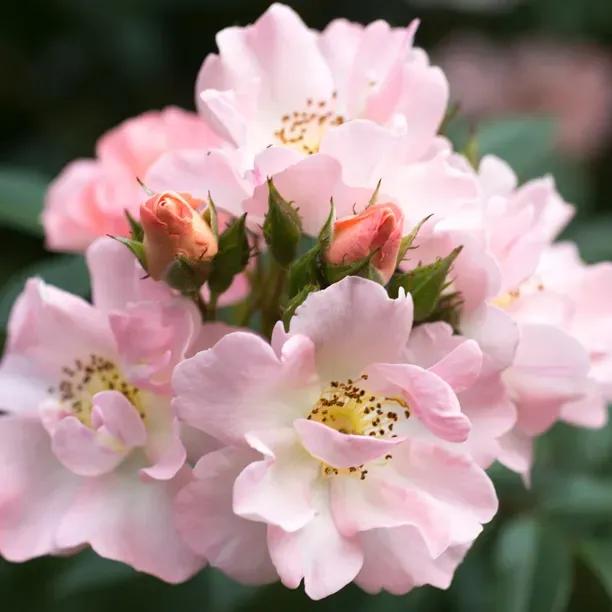Open Arms Rambling Roses

The details
- Group: Small Rambler
- Colour: Pink
- Height: 2m
- Scent: Medium, musky
- Flowering: Jun-Nov
- Size: 5cm
- Glossy leaves, good in shade
- Large flower clusters
- Popular with bees & butterflies
Recommended extras
Description
Open Arms Rambling Rose
Open Arms is a compact rustic rambling rose awash with large clusters of simple shell-pink flowers all summer and into autumn. The fragrant open blooms are dainty, with a spray of golden stamens at the centre. They're held in generous clusters, so the overall effect is bountiful and glorious. They're also hugely popular with bees and butterflies. It's a restrained rambler, reaching around 2m in height, so ideal for smaller gardens or courtyards, used to cover a pergola, rose arch or to grow around a front door.
Take a look at our full range of roses.
- Group: Rambler
- Colour: Pale pink
- Height: 2m
- Scent: Medium, musky
- Flowering: Repeat flowering from June to November
- Size: 5cm
- Glossy leaves, good in shade
- Large flower clusters
- Popular with bees & butterflies
Growing Open Arms Roses
Although this variety will do well in poorer soils with partial shade, and can even handle an open North-ish facing site with plenty of indirect light, like almost any rose it thrives in full sun or light shade with rich soil: heavy clay is good.
Mulch in spring with garden compost or manure, feed with a balanced fertiliser in early spring and early summer. Do not allow to dry out in hot summers, even when well established.
Prune in late winter.
Planting Companions for Open Arms
This is a rustic, cottagey rambler in a soft pink, so companions with qualities in the same vein work well. As underplanting, hardy geraniums are tried and tested miracle workers, anchoring roses at ground level, growing up to disguise bare stems at the base and providing simultaneous colour in complementary tones of purple, pink and white, depending on the cultivar you choose.
For interest earlier on, spring bulbs are a great choice, so plant muscari, snowdrops, crocus and more in autumn to bridge the seasonal gap.
This is a rose that doesn't mind a bit of shade. So exploit this in an east or north(ish) facing border by adding foxgloves to the mix.
Weave through a summer-flowering clematis or two, and you'll have double the colour at head height. Any will do, but plum-colour Sunset would make a juicy long-term partner, flowering from June right through to September.
Did you know?
This rambler, or miniature climber, was bred by world-renowned rose breeder Chris Warner of Newport, Shropshire, to be a short patio climber. It was introduced in 1995. It's a cross of orange-red floribunda Mary Sumner and ground cover rose Laura Ashley.
Chris Warner is known for his innovative rose varieties, bred with today's gardens in mind. Open Arms is a great example, being great for pollinators, tolerating shade and poor soil and remaining nicely compact.
Big on symbolism, the Romans used to hang roses from the ceiling as a sign of confidentiality. Basically it meant 'Anything said under the roses, stays under the roses', in a bid to safeguard the effects of wine. This is where the term sub rosa comes from.
Elsewhere, pink roses symbolise gratitude, grace, admiration and joy.
Planting Instructions
How to plant Open Arms Roses
Choose a spot with as much light as possible. Improve the soil from the hole by removing roots, weeds, large stones and other rubbish and mixing in about 25% by volume of well-rotted compost or manure.
Position your rose so its roots are spread out, wet them and sprinkle them with Rootgrow mycorrhizal fungi.
Then backfill the hole with mixed soil and compost, firming it gently as you go. Water in thoroughly.
Deadhead. Prune in late winter.
Watch a video on how to plant a bare-root rose here.


